Contents
Source of Cataloguing
- EPL catalogues videorecordings using first and foremost the information found on the label, container, or packaging.
- However, "if information required to identify the resource does not appear on a source forming part of the resource itself, take it from one of the following sources in order of preference" (RDA 2.2.4 Other Sources of Information):
- Accompanying material (e.g. a leaflet)
- Other published descriptions of the resource
- A container that is not issued with the resource itself
- Any other available source (e.g. reference source, such as IMDb)
- Information taken from elsewhere, including the video itself, is to be enclosed in square brackets if recorded in the 245 field (see RDA 2.2.4, Other Sources of Information):
245 00 Aladdin and the king of thieves|h[videorecording] /|c[Tad Stones, director].
- Generally additional information may be left in derived and vendor-supplied records, but follow EPL policy for 245 and added entries.
Added Editions
- When the format or content of a videorecording has changed significantly, a new record is required
- Items with such changes as new translations for dubbed films, colourized versions, additional footage (e.g., short film, omitted scenes restored, etc.) are to be treated as added editions or pseudo-duplicates to satisfy outstanding holds
- Subtitles or soundtracks in an additional/different language do not warrant a new record; remove the original 546 note as appropriate
- Digital remastering does not constitute a new edition
- Generally a new record is not made for the absence or addition of material clearly identified as being “bonus” material
Bonus Material
- Bonus material which is clearly identified can be disregarded for cataloguing purposes (i.e. description, classification, subject headings); material not identified as being “bonus” will have to be considered
- When necessary, use 5XX notes to clarify classification (including language in call no.), subject headings, etc.
500 Featuring highlights from Mozart’s opera ...
- See also 500 Notes, Bonus Content
Blu-ray Videorecordings
- Blu-ray discs are catalogued with a separate title record, i.e. do not treat as pseudo-duplicates of the DVD
- 007 vd*|s||||
- “Blu-ray” is used as the call number prefix
- The GMD remains |h[videorecording] and the 300 $a remains “videodisc(s)”
- Notes will be made in 500 and/or 538 fields to clearly identify the Blu-ray disc
099 \\ Blu-ray J MUP
245 04 The Muppet Movie|h[videorecording] /|cdirected by James Frawley.
300 \\ 1 videodisc (95 minutes) :|bsound, color ;|c4 3/4 in.
538 \\ Blu-ray Disc; requires Blu-ray player.
Combo Packs
- DVD + bonus Blu-ray vs. Blu-ray + bonus DVD
- Designate the primary format of combo packs based on the fund code used at the time of ordering, i.e., if a videorecording is ordered as a Blu-ray, the call number prefix should be Blu-ray; if ordered as a DVD, the call number prefix should be DVD
- The Contents note and label will list the “primary” item first (see 300 below)
Classical Music Videorecordings
- Title main entry is applied
- Consult the rules for Classical Sound Recordings
- Ideally, the composer(s) and librettist(s) would be the first names followed by the individual principal performers, choirs, and orchestra. Conductor would follow individual vocalists. Director(s) would be the last named of the principals. (All 700s precede 710s)
- Knowing who is the (stage) director or (recording) director could immediately identify a duplicate if the date of the recording remains the same. It is possible that the recording could be different even if the same stage director was involved if one is a recording of Tuesday's cast as opposed to Saturday's opening night cast.
- Knowing who is the librettist is important for operas since an opera can be offered in more than one language or translation (Verdi's Italian Rigoletto has been performed in German: Piave's libretto translated by Kozub; Handel's German Giulio Cesare into English as Julius Caesar: Bassani's libretto translated by Haym).
- Composer is very important (Puccini is the composer whose uniform title Fanciulla del West may be identified on label and package as Girl of the West; Mozart is the composer whose German uniform title Zauberflöte collocates versions which may be identified as The magic flute, Il flauto magico, etc.) as are principal performers/opera companies so including them as added entries in any order is basic cataloguing. It is still of interest to know whether Rigoletto is being sung by Pavarotti or by any other tenor.
- Any other names, e.g. Shakespeare for Britten's A midsummer night's dream, are discretionary since the cataloguer may be unable to judge how much the adapted form owes to the original.
Do not make uniform titles for classical pieces that are included in the videorecording only to serve as examples or accompaniment for the text, use a 500 note if required for clarity, e.g.
245 What does music mean|h[videorecording].
500 Includes excerpts of classical music.
The Great Courses
- Catalogue titles of The Great Courses series as multi-volume sets if the content exceeds approximately 6 hours. Include approximately 12 lectures, or about 6 hours of content (usually 2 discs), per part.
- Since the discs are numbered, specify the disc numbers included in each “part” in a 505 field. Label as “pt.”
- If there is one accompanying book, include it with pt. 1.
- If there are insufficient books to include one with each copy, do not include the book details in the 300 |e subfield. Do, however, include a 500 note in the record.
500 Book included with pt. 1.
- Components housed in an oversize case (measuring 30 cm x 28 cm) recieve an Oversize label and an Oversize home location (e.g. MOVIESOVR), also include a note in the record, e.g.
500 Study workbook included with pt. 1 only -- in one oversize container.
- For duplicates, edit the record as required.
As of September 2025, CVS Midwest Tape has begun supplying The Great Courses series. Instead of issuing print booklets, CVS Midwest Tape is providing PDF links to some booklets.
- If EPL purchases additional copies that do not have a print booklet, include a 500 note:
500 Some copies have PDF booklet linked in catalogue record.
Multi-item Series/Sets
- Catalogue videorecordings received as part of a multi-item set individually if they are about substantially different subjects or if they are stand-alone titles, e.g. a collection of previously released feature films.
- A set of previously released feature films may be broken up and packaged individually (a booklet may be discarded if it does not relate to any one film. If there is uncertainty about discarding an accompanying booklet, consult with a librarian.)
- Although a season of a TV series or mini-series should be catalogued and packaged as one item when possible.
For TV series with complex numbering, e.g., where season and volume numbers appear, include additional numbering in the 099/092 field as per the following example
Ancient aliens. Season 5, volume 2 would be 092 DVD 001.942 ANC s.5, v.2
- For separately catalogued items received as a multi-part set, include in each individual record identifying item numbers for the set (020, 024 and/or 028) if available, 490/830 series entry for the title of the set, and an explanatory 500 note, e.g.
020 1417076100 (on original 5-DVD set pkg.)
024 025192948725|c(5-disc set)
028 29487 (on original 5-DVD set pkg.)
245 Cleopatra|h[videorecording]
490 The Cecil B. DeMille collection
500 Originally acquired as part of a 5-DVD set with collective title The Cecil B. DeMille collection, now treated as series title in this record.
830 Cecil B. DeMille collection
- For large on-going sets, e.g. Nova, Frontline, catalogue each videorecording separately.
- Accept titles catalogued by vendors as-is, with either a 245 $a $p or a 245 and a 730. Do not recatalogue.
- Continuous programs contained on multiple items should be catalogued as one item. See also Episode titles.
Shakespearian Videorecordings
- Videorecordings of Shakespearian plays whether from screen or stage are classified in 822.33 and cuttered from the special Shakespearian table.
- Main entry is always Shakespeare.
- This does not apply to loose adaptations which do not use Shakespearian dialogue.
Silent Films with Music
300 :|bsd.
500 Silent film with music score.
650 Silent films.
E, J or Teen Videorecordings
- Set fixed field Audience to:
- j for E or J
- d for TEEN
- To determine if E or J consider:
- Intellectual content: E fiction, fiction containing a minor amount of factual information and simple concept videos for preschoolers, grades 1 and 2; quite juvenile in content [See Juvenile Print, E section; do not be guided by the rules which allow Dewey classification of fairytales, nursery rhymes or poetry; this applies only to print format titles]
- E video recordings should not be classified using Dewey; rarely should material for preschoolers be moved to J with a Dewey classification number. All titles in the Baby Einstein series or Baby Genius series should be classed in E + Cutter. Similarly consider other titles in series for uniform treatment.
- For titles which contain substantial amounts of factual information, class in J + Dewey + Cuttter e.g. Animal atlas: Family time -- DVD J 591.563 ANI
- Cartoons are generally J as they are for a broader audience, e.g. Looney Tunes Show.
- Length: Consider only if in doubt of content; if less than 30 minutes, probably E; more than 30 minutes, J
- If videorecording is in a series, check WorkFlows for classification of others, e.g. My Little Pony Equestria Girls series set at Canterlot High -- DVD J MY
- Examples of E videorecordings:
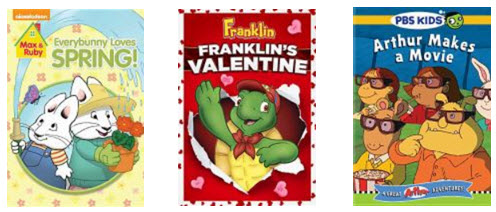
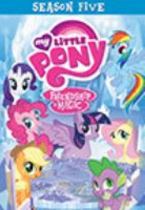
DVD E MAX DVD E FRA DVD E ART DVD E MY / My Little Pony Friendship is Magic, 30 min episodes
Walt Disney Videorecordings
- Most videorecordings manufactured by Walt Disney should be classed as E, J or TEEN.
- Disney films such as Beauty and the Beast, Sleeping Beauty, Cinderella, etc. should be treated as feature films and should not include the Dewey classification of fairytales in the call number, e.g. DVD J 398.21 BEA. Call numbers should include format (DVD or Blu-ray) + audience + Cutter:
099 DVD J BEA
245 Beauty and the beast [videorecording]
099 Blu-ray J CIN
245 Cinderella [videorecording]
099 DVD J DIS
245 Disney's Robin Hood [videorecording]
- Included are children’s and “family” (i.e. suitable for all ages, but primarily for children).
- Walt Disney videorecordings for ages 17 and up should be classed as adult.
- Make a 710 for Walt Disney Productions (or variant). The 710 chosen must be justified in the bibliographic record.
710 Walt Disney Productions
710 Disney DVD
- To determine if J, teen or adult:
- Class titles according to the intended audience.
- Most titles that appeal to all ages are classified as adult.
- Titles appealing primarily to children are classified as juvenile or teen.
- Generally, material for ages 17 and up should be classed as adult.
- DO NOT recatalogue films/soundtracks from adult to E/J/TEEN and vice versa if the intended audience is not absolutely clear: for borderline or doubtful cases, use existing classification.
- DO recatalogue if the classification is obviously in error.
Teen Videorecordings
- This collection is designed for ages 13 to 17.
- Cataloguers may exercise judgment regarding the classification (confirm with appropriate Collections Librarian).
- These rating sites may be useful in determining the call number:
Alberta Film Ratings
MPAA (Motion Picture Association of America)
MPA Canada
MARC Coding
007
- Insert field 007 into the record in MARC Tag order
- Select values from the drop down menu
- When saved and the field closed it will thereafter display as 007 vd*|s|||| (for Blu-ray) or 007 vd*|v|||| (for DVD)
- Accept other values in derived and vendor-supplied records as long as these minimal three positions are correct
- For combo DVD/Blu-ray packs, use only one 007, choosing “s” or “v” to match the primary content
- Do not revisit DVD records to add field 007
- See MARC 700 - Videorecording
007
v Videorecording
| No attempt to code
| No attempt to code
v / s DVD/Blu-ray
| No attempt to code
| No attempt to code
| No attempt to code
| No attempt to code
024 UPC
- Include 024 as the first identifier in videorecording bibliographic records to support cover image display in the discovery layer, e.g.
024 1\ 786936836554
028 Publishers' Numbers/Names
- Record all publishers numbers.
- Only record publishers/distributors names in |b if required for identification (e.g. for pseudo duplicates, reissues from a different publisher).
- For more information on recording publishers’ numbers (or ISBNs), see Sound Recordings general, 028.
09X Call Number
- 123 = DDC
- ABC = Cutter
DVD ABC | DVD 123 ABC |
DVD E ABC | DVD J ABC |
DVD J 123 ABC | DVD French ABC |
DVD French 123 ABC | DVD E French ABC |
DVD J French ABC | DVD J French 123 ABC |
DVD TEEN ABC | DVD TEEN French ABC |
Blu-ray ABC | Blu-ray 123 ABC |
Blu-ray E ABC | Blu-ray J ABC |
Blu-ray French 123 ABC | Blu-ray E French ABC |
Blu-ray J French ABC | Blu-ray J French 123 ABC |
Blu-ray TEEN ABC | Blu-ray TEEN French ABC |
- When constructing call numbers for TV series on DVD or Blu-ray, use s. for seasons; v. for volumes; and pt. for parts in 09X fields (effective July 25, 2024).
- Do not double cutter for those items which are not classified by DDC, i.e. feature films.
- But do continue to double cutter for subjects. See Double Cuttering and Double Cuttering for Audio-Visual Material, e.g.
245 NHL’s Oilers review
610 Edmonton Oilers (Hockey team)
092 DVD 796.96264 EDM NHL
- Instant fireplace [videorecording] shows a fire burning in a fireplace with the sound of the fire crackling, etc. Class in 791.4566 for TV programs dealing with physical and natural phenomena. Use 650 |a Fireplace |v Miscellanea. Note: Use as pattern for similar videorecordings, e.g. fish swimming in an aquarium.
- Videorecordings which feature photography of outdoor scenes accompanied by a soundtrack of music will be classified in 913-919, according to the geographic region shown.
- Reading Rainbow videorecordings are classified according to the featured book, rather than the entire content of the program (i.e. E if featured book is E; nonfiction if featured book is classified as non-fiction).
Foreign Films & Anime
- For videorecordings where the primary sound track is in a language other than English, including classical music videorecordings, include the language in the call number prefix, e.g.
092 DVD French 306.446 PAR
092 DVD J French 448.341 POU
099 DVD Persian CHI (for Persian/Farsi)
099 DVD TEEN French CON
- Set fixed field Lang: eng, jpn, etc. (in Workflows) to match the language in the call number.
- For films that have sound tracks in a language other than English and English (e.g. English and Japanese; English and French, etc.), do NOT include the non-English language in the call number prefix except in rare cases. In these exceptional situations, include a 590 stating "Title ordered for foreign film collection, Date."
E.g. The call number for Red Data Girl (with audio in English and Japanese with English subtitles) would be:
099 DVD TEEN RED
NOT
099 DVD TEEN Japanese RED

E.g. Dragon Ball Z (Dragonball Z) DVDs and Blu-rays (often with English and/or Japanese dialogue):
099 Blu-ray TEEN DRA
NOT
099 Blu-ray TEEN Japanese DRA

- For double-sided bilingual packaging/artwork for DVDs and Blu-rays, use the English side out, e.g.

(English) Barcode and call number labels should be on this side. Not the reverse (French).
- Always make title added entry for the non-English titles of a foreign film.
- For non-English films where the packaging/artwork provides only the English title, provide original title from the film or an alternate source, e.g. IMDB, All-movie guide, in a 246.
- There may be cases where it makes sense to have the English-language title appear in the 245 and cutter/label accordingly. Particularly when the item-in-hand is packaged and presented for an English-language audience.
E.g. Vendor-supplied record:
245 Shunpuden
099 DVD Japanese SHU
This was changed to:

E.g. Vendor-supplied record:
245 Il Commissario Montalbano
099 DVD Italian COM
This was changed to:

- Do not add language to call number for Classical Music DVDs that feature more than a non-English vocal performance, e.g. also includes commentary in English; when in doubt, do not add language to call number.
- For more information on coding fixed field Lang, see MARC Code List for Language.
Operas & Musicals
- Include samplers intended by manufacturer to present opera music in 792
- When staged and filmed from the stage, class in 792
- An opera filmed on location as well as a stage opera recorded for TV is still considered a stage presentation (i.e. not a feature film) and should be classed in 792.542.
E.g. The New York City Opera's production of Lizzie Borden (music by Jack Beeson, libretto by Kenwald Elmslie) filmed in 1999:
092 DVD 792.542 LIZ
245 Lizzie Borden|h[videorecording] /|cdirected for television by Kirk Browning.
700 Beeson, Jack,|d1921-2010.
- For operas in a language other than English, cutter for the title that appears on the item. See also Foreign Language Films.
E.g. Prince Igor filmed at The Met in New York:
092 DVD Russian 792.542 PRI
245 Prince Igor|h[videorecording] /|cdirector, Gary Halvorson.
546 Sung in Russian; with optional subtitles in English, German, French, Spanish, Chinese or Korean
700 Borodin, Aleksandr Porfirʹevich,|d1833-1887.|tKni͡azʹ Igorʹ.
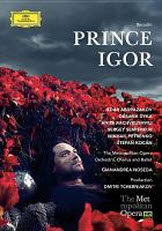
- If a production has been clearly altered for a different medium, e.g. scenes have been omitted from a recorded staged opera production because the length of the recording had to be reduced for TV, class in a number other than 792.
- When dramatically adapted, class as a feature film, i.e. a film that happens to be comprised of operatic content, e.g.
Verdi's La Traviata as directed by Franco Zeffirelli (1983; a theatrical release nominated for 2 Academy Awards and nominated as best foreign language film for the Golden Globes
092 DVD Italian TRA
245 La traviata|h[videorcording] /|c[stage director, Peter Konwitschny ; directed for TV and video by Myriam Hoyer].
700 Verdi, Guiseppe,|d1813-1901.
Mozart's The Magic Flute, as directed by Ingmar Bergman (1975; made for Swedish TV) or as The Magic Flute directed by Kenneth Branagh (2006; made for widescreen theatrical release), etc.
092 DVD Swedish ING
245 Ingmar Bergman's the magic flute|h[videorcording]
700 Mozart, Wolfgang Amadeus,|d1756-1791.
- Class recorded stage musicals in 792.64... E.g.
092 DVD 792.642 SUN
245 Sunday in the park with George
Ballets
Fictional Television Programs/Specials
- These videorecordings are not classified using DDC.
- Individual seasons of a television series should include the season number in the volume field.
- Class in fiction as the following examples indicate:
I love Lucy [VR] | DVD I |
Coronation Street [VR] | DVD COR |
Animal Kingdom. Season 6 [VR] | DVD ANI s.6 |
Black Adder III [VR] | DVD BLA |
The solitary cyclist [VR] | DVD SOL |
1XX Main Entry
- Use title main entry
- RDA (at 6.27.1.3 Collaborative works: Exceptions) prescribes:
“For motion pictures, video games, etc., construct the authorized access point representing the work by using the preferred title for the work (see 6.2.2).” E.g.
Vendor supplied record:
09X DVD German STR
100 Strauss, Ricard,|d1864-1949.
245 Capriccio|h[videorecording]...
EPL preference:
09X DVD German 792.542 CAP
(No 100)
245 Capriccio|h[videorecording]...
700 Strauss, Richard,|d1864-1949.
- Vendor-supplied cataloguing using title main entry is to be expected and is accepted as-is.
245 Title
- See also 505, 740
- When credits for performer, author, director, producer, "presenter", etc., precede or follow the title in the chief source, generally do not consider them as part of the title proper, even though the language used integrates the credits with the title.
- Use underlined portion in the following examples as the title.
Twentieth Century Fox presents Star Wars | Steve McQueen in Bullitt |
Ed Asner as Lou Grant | Jerry Wald's production of The story on page one |
Ordinary People, starring Mary Tyler Moore and Donald Sutherland | Thief, with James Caan |
Titles which are linked to a name with an apostrophe ('s) | |
But: | But: |
Parallel Titles
- Make title added entry for the non-English title of a foreign film when the information is readily available.
- See also Cataloguing Overview, 246 Parallel Titles.
Episode Titles
- See also 740
- For Lonely Planet travel videos, record title as |a. |p (Lonely Planet is a television program), e.g.
245 Lonely Planet.|p Nepal|h [videorecording]
- Note:
245 Yes, Prime Minister.|p Power to the people |h [videorecording].
505 The patron of the arts--The National Education Service--The tangled web.
- Where there is no prominence given to a particular episode, use first episode in 245 |p and an ellipsis (...) to indicate omission. Record remaining titles in 505.
- If |c information (directors, etc.) is same for all episodes, record in 245; if information differs for each episode and directors, etc. are not being traced, omit information from record. If directors, etc. are being traced, record |c information following respective title information in 245 and/or 505.
245 |c Statement of responsibility
- Limit statements of responsibility to names of persons and corporate bodies credited in the chief source of information with a major role in creating a film (e.g. directors) [RDA 2.4.1.4].
- Record up to three prominently given animators in the 245 |c but do not trace [see also 7XX Added Entries below].
- All other statements, if considered important, should be given in 500/511 notes, e.g.
245 The man of the year|h[videorecording] /|ca film by Jose Henrique Fonseca.
[Note that “a film” is considered part of the statement of responsibility]
- Prefer the use of a note if item is a collection of more than three television episodes, etc., where each episode has a different director, e.g.
511 Directors vary for each episode.
- Writers may also be included here if they fit the above definition.
- Names of producers are not recorded in the 245 |c (or elsewhere) unless required to identify a generic title.
- Names of composers and/or lyricists are recorded in a 500 note rather than in the 245 |c.
- Note and trace a composer’s name on a popular music videorecording only if given prominently on the item.
- For non-music videorecordings, cataloguers are to consider the importance of the music when determining whether or not to note and trace the composer.
246 Variant Titles
- Use as required, e.g.
246 1 |i Container title:|a _____
246 3 Walt Disney’s Dumbo|h[videorecording]
500 At head of title: Walt Disney’s
- Make a 246 on request for alternative release titles. Do not trace working or trailer titles, e.g.
246 1 |iAlso released under title:|aKanal|h[videorecording]
250 Edition Statement
- Widescreen and full screen editions of the same title may be catalogued on the same record.
- Use or create an edition statement from format information provided on the item, e.g.
Widescreen [ed.] ; Letterbox version ; Anamorphic [ed.].
- Use [Colorized ed.] for tinted films if it can be easily verified that the original film was black and white.
- Use a 250 edition statement only for those items containing a single version; for items containing multiple versions, add a 500 note, e.g.
500 Contains both formats or Contains both full screen and widescreen formats
National Film Board of Canada French Videorecordings
- Some NFB French videorecordings have the same title as the English version. If necessary, add 250 |a [French version] to help distinguish between versions.
26X Publication Information
264 |a Place |b Name
- Record the place and name of publisher(s) and/or distributor(s) of the video/DVD, not the original film; but when in doubt (or an extensive research would be required), record all names.
- Do not record those names which do not have a publication/distribution function, e.g. management companies or firms providing artwork, etc.
- Prefer the form of name of the publisher/distributor as given in the logo.
- Use overtly stated places of publication or "Place of publication unknown"
264 [Place of publication unknown] :|bCBC Home Video
264 Toronto :|bDistributed by Morningstar Entertainment
264 |c Dates
- The date of publication or the copyright date (if no publication date), of the videorecording is the date to be used in the 260 or 264 |c.
- If this date is not on the item, use an approximate date; EPL will use 1998 as the earliest possible date of publication for DVDs and 2003 for Blu-rays.
- If there is no publishing date for the videorecording as a whole, the date of artwork/design/packaging can be used to infer the date, eg. if the copyright date of packaging is given as c2003, use [2003]. If, on the same item, there is an earlier copyright date referring to the item as a whole (i.e. not just the packaging), also use it (if an appropriate date, see above), e.g.
264 |c [2003], c2001.
- If an overtly stated date is given on the item, use without further checking (if appropriate), eg. DVD has date c2000:
264 |c c2000.
- The copyright date or date of release of the original film is recorded in a 500 note; see 500 date of original release or copyright (below).
- For items which include a complex set of dates, i.e. compilations, disregard all multiple copyright dates and use the last date (if appropriate) to infer the date of videorecording release. Give this date in square brackets, e.g.
c1965, c1967, c1971, c1988 on item
Dat tp: s Dates: 1988
264 |c [1988?]
- If no date of videorecording publication is given and if using the above instructions will result in a known incorrect date, consult an outside source, e.g. All-movie guide (on line) or IMDb. Use question mark with 26X date if date taken from outside source (unless noted in record in a 500 note).
Coding of Date Fixed Fields
- Code "p" is used when the date of release is not the same as the date of production (filming/recording).
- Code "p" is also used for videorecordings which are identical in content but have a later release date than the original film; note that most DVDs contain extra material and are not identical in content to the original film and so will use code “s”; indicate the presence of bonus material by using the note: 500 Includes bonus material.
- Code "t" is used when the date of release differs from the copyright date of the videorecording or original film.
- For most videorecordings (monographic items) the precedence of codes used for “Type of date” are:
s Single date
p Distribution/production date
t Publication date and copyright date
q Questionable date
- Refer to MARC coding manual for more information on precedence of codes and filling of f.f. dates.
Dat tp: s Dates: 1995 | Blu-ray artwork copyrighted 2011. No other copyright or release date. |
Dat tp:s Dates: 2004 | DVD is c2004; original film released in 1962. DVD contains special features. |
Dat tp:s Dates: 2003 | Only date on DVD is 1966; date information taken from on-line source. DVD includes special features. |
Date tp: p Dates: 1996 1994 | Both dates given on DVD (518 = date of creation or filming) |
Dat tp: p Dates: 2000 1942 | No dates given on DVD; no bonus material. Date information taken from on-line source. |
Dat tp:t Dates: 1998 1980 | DVD only gives c1980 (for film). DVD received by EPL in 2005. No bonus material. |
Dat tp.: q Dates: 2004 2013 | No information available for Blu-ray received by EPL in 2013. No film copyright date or date of original release. |
3XX Physical Description
- Cataloguers are to determine if a Contents label is required; if it is, the required information (in the correct order) is to be noted on the IP form to the right of the call number, e.g.
#1. 300 2 videodiscs (1 hr., 56 min.) :|bsd., col. ;|c4 ¾ in.
Three possibilities:
Contents label (2 DVDs): 2 DVDs
Contents label (DVD + Blu-ray) : 1 DVD
1 Blu-ray
Contents label (Blu-ray + DVD): 1 Blu-ray
1 DVD
#2. 300 1 videodisc :|bsd., col. ;|c4 ¾ in. +|e1 booklet.
Two possibilities:
Contents label (DVD): 1 DVD
1 booklet
Contents label (Blu-ray): 1 Blu-ray
1 booklet
- For example of Blu-ray audio disc, see Sound Recordings Overview, 300 Bonus CDs, DVDs, etc.
- Additional DVD(s) containing bonus material are not “bonus DVDs”; record the number of all DVDs in the |a subfield.
- Digital copy: Some “combo packs” may include a bonus “digital copy” [i.e. a computer file to be downloaded to a computer or other portable device] intended for single-use only. Discard disc and add 500 note, e.g. Single-use digital copy discarded from library copies. If the digital copy is not a separate disc, add appropriate 500 note(s), e.g.
500 ”Blu-ray + DVD + digital copy”—Container.
AND
500 ”Serial number that permits access to digital copy has been discarded from library copies”—Container verso.
- Record a prominently presented time for the item as given; do not interpret if it is only for part or all of the material comprising the DVD item. If item states “approximately 120 min.”, use 300 1 videodisc (ca. 120 min.)
Accompanying Material
- Cataloguer is to assess any accompanying print material and mark with an X any material which is not necessary to retain.
- Print material which is retained will generally not be glued or taped to the container; when possible, booklets of 5-48 pages will be trimmed to fit inside the case.
- Note that print material which is glued, taped or otherwise attached to the container will not be recorded in the 300 or on a Contents label.
- Leaflets (4 p. or less) are retained only if important and are not included as contents in the 300 or on a Contents label; single sheets listing contents of the DVD will be discarded by processers if they do not fit without folding or trimming.
- A Contents label will be provided when the item contains more than 1 DVD or contains any loose material of more than 4 p. and will be affixed below the machine-readable barcode (same orientation as barcode).
- Textual material will be identified as either a booklet (between 5 p. and 48 p.) or as a book (more than 48 p. or in hardback format).
- See also Cataloguing Overview, Accompanying Material.
5XX Notes
At Head of Title Notes
- Abridge lengthy at head of title information with the use of the ellipsis to indicate omission.
- Always include the first five words.
- Include in the "at head of title" note performers' names that are grammatically linked to the title; otherwise include these names in a 511 note, e.g.
500 At head of title: Harrison Ford in.
but
511 Starring Harrison Ford, with others; ...
[at head of title information reads: Harrison Ford]
- Date of original release/production or copyright, e.g.
500 Original film released in 1956.
500 Film copyrighted 1956.
500 Program originally produced in 2008.
500 Originally copyrighted 2002.
Films Without Dialogue
- For films without dialogue add note:
500 Without dialogue.
- Do not suggest such films are suitable for the deaf and hard of hearing.
Episodes from a TV show
- Record a note of the type: Episodes (or An episode) of the television program … or, Featuring characters from the television program …
- Do not use the shorter term “TV program”.
- Do not use a subject heading to indicate a relationship to a TV show.
- Video Format: Record information which does not constitute an edition statement, but which is useful for identification, as a 500 note.
- Also use a 500 note for an item containing multiple versions, e.g.
500 Available in both widescreen (side A) and fullscreen (side B) formats.
500 Includes NTSC and PAL versions on either side of disc.
Technical Information
- Generally do not make notes for technical data, e.g. Dual layer format; Reformatted for ... ; sound characteristics, e.g. English DTS or Dolby digital 5.1 (i.e. trademarked 5 full range Left-Center-Right and 2 Surround channels plus a low frequency effect channel), Spanish 2.0 (i.e. stereo or Left and Right channels), and Thai LCRS (i.e. Left-Center-Right-Surround channels), etc.
- If in doubt, record information in a 500 quoted note, e.g. 500 |a”DVD-R”.
- If presented as a formal edition use as a 250, e.g., 250 |aDual layer ed.
- When the only format available may not be generally playable, do make a note alerting staff and customers, e.g.,
500 Produced for DVD Zone 4 (for Australia) and in PAL video format; viewing depends on availability of compatible player/television.
Indicate on IP form: PAL sticker required.
Bonus Content
- To indicate the presence of bonus content or special features, use the note:
500 Includes bonus material.
- Do not make notes to identify special features, e.g. interviews, outtakes, documentary on making the film, special footage, etc., unless required for identification (in which case, consider using 505 Partial contents note).
- Make note of any material that has been discarded from the DVD/Blu-ray, e.g. toys, single-use access codes for obtaining a digital copy or Ultraviolet streaming version of the content, etc. Make a note on the IP form for item entry processors to discard codes and affix appropriate label.
- See also Item Entry & Processing.
500 The “single-use serial code” allowing registration for online features discarded from library copies.
500 Single-use code for access to digital copy discarded from library copies.
500 Single-use code for access to Ultraviolet streaming copy discarded from library copies.
Public Performance Rights Videorecordings (PPR)
- Acquisitions staff will mark PPR (public performance rights included) on the IP form or otherwise notify cataloguers. Make note as follows:
500 Public performance rights included.
- Processing will affix sticker: Canadian public performance rights.
- If some copies do not have PPR, remove note "Public performance rights included."
505 Contents Note
- Make note of contents as warranted.
- Accept 505 note in derived records if contents can be confirmed from packaging. It is not necessary to make note of the track/chapter listings.
- For compilations of cartoons and short films, use discretion in adding 505. May be useful for distinguishing similar titles and for keyword access to titles of well-known short films.
508 Credits Note
- EPL does not require 508 notes in original records
- Vendor supplied cataloguing with this field should be accepted as-is.
511 Participants and Performers Note
- Record up to three prominently given performers/participants in original cataloguing; if no names are featured, the first named person of a list can be noted and traced, e.g.
511 Instructed by Tom Smith.
511 Featuring Donald Sutherland and Julia Roberts. [use when 3 or fewer performers are featured]
511 Starring John Smith and others. [use for the 1st named person of a list]
- Accept vendor cataloguing with more than three performers of a type listed in a 511 as-is, but trace only the predominant three.
- If it is not immediately obvious as to which performers should be noted in 511, also consider the importance of the role played by the various characters in the film.
- When data is taken from a source other than the item, make a note identifying the data and the source.
500 Credits from NFB website.
500 Director from IMDb. [See also Cataloguing Overview, 500 Local Notes]
511 Narrated by Donald Sutherland. Cf. IMDb.
518 Date of Filming, Creation or Broadcast of film/video
- Include note only if information is readily available on the item and significant to the content, e.g.
518 Filmed on location in Rome in 1976.
518 Contains 13 episodes originally broadcast in 2011.
520 Summary
- Accept 520 as given in derived records.
- Supply a brief summary statement in original cataloguing where information is readily available, particularly for obscure or lesser-known titles.
- Include names of contributors to provide access where added entries may not be warranted.
521 Target Audience
- In derived records, retain a correct 521 audience field note. Do not check or edit field.
- Include rating in original cataloguing if information is readily available on the item itself.
538 System Details Note
- Generally not required, but do use for Blu-ray items, e.g.
538 Blu-ray disc; Blu-ray player required. [Blu-ray only item]
538 Blu-ray disc requires Blu-ray player. [combo pack]
538 3D Blu-ray disc requires full Blu-ray 3D Player, High-speed HDMI cable, compatible 3D glasses and full HD 3D TV. [combo pack]
- Accept 538s in derived/vendor-supplied records as-is.
546 Language Note
- DVDs may contain closed-captioning (for the deaf), audio description, subtitles and multiple language soundtracks. Note all language features available.
- Make appropriate note for dubbed versions, e.g.
546 Dubbed into French.
- Record language of soundtrack and/or subtitle(s) as given on the item; use the word “available” to indicate optional subtitles, e.g.
546 Soundtrack in English or Spanish. [two soundtracks available]
546 Soundtrack in English and French. [one soundtrack with both languages being used as dialogue]
546 Soundtracks in English, French, Spanish or German; subtitles available in English, Italian or Greek. [for soundtracks and subtitles available in various languages as specified]
546 Subtitles available in English or French [choice of subtitles]
546 Soundtrack primarily in English or French with some Spanish.
- It is not necessary to record the language(s) of the menu screens.
- If DVD is completely in English (i.e. English soundtrack, no subtitle information), it is not necessary to make the note: 546 Soundtrack in English.
Subtitles for the Deaf and Hard-of-Hearing (SDH)
- “SDH” - an acronym for "Subtitles for the deaf and hard-of-hearing" - is an American term the DVD industry introduced.
- Record in 546 if given on item, e.g.
546 Subtitles available in English SDH.
546 Subtitles available in English, English SDH or French SDH.
Closed-Captioned (CC)
- Closed-captioning is indicated by words or an icon either
 or
or  or variants, e.g.
or variants, e.g.  but not
but not  which means “accessible to the deaf” but does not specify how; instead of captioning, for instance, a DVD may have sign-language interpretation provided or amplified sound.
which means “accessible to the deaf” but does not specify how; instead of captioning, for instance, a DVD may have sign-language interpretation provided or amplified sound. - Use as a 546 Language note (a separate field is preferred), e.g.
546 Closed-captioned.
- DVDs are not identified for CC at the item level. If some copies of a title are closed-captioned and some are not, do not include the closed-captioned note.
Audio Description for the Visually Impaired
- Note the presence of audio description in a note following notes on soundtracks and subtitles, e.g.
546 Closed-captioned; audio description available.
or
546 Audio description available.
- DVDs with audio description, not to be confused with Descriptive Videos, do not usually require separate catalogue records; they often are released with options for many audiences to select.
586 Awards Note
- Use only for awards, not nominations.
- Accept derived/vendor-supplied cataloguing as-is.
- Ensure records have a 655 local genre heading for select award-winners. See 655 Local Genre Headings.
6XX Subject & Genre Headings
- Subject headings are retained in records for adult feature films, regardless of the supplying vendor, and included in original records for videorecordings.
- Topical subject headings must be present in films for teens and children, too.
- Add subject headings to films from all countries as appropriate, e.g Musical films$zIndia.
- See Subject headings for general subject heading instructions.
- See Subject headings, Videorecordings for specific subject headings for Adult and Juvenile videorecordings.
655 Local Genre Headings
- In addition to 586 fields where specific details about which award(s) were won and in which year each award was made, add these selected local genre headings:
- Additional information in 586 fields provided by vendors e.g. names of the individually honoured actors and additional awards (cinematography, etc.) may be left in 586 but only the awards enumerated in the example fields will justify these local 655s.
- In the event a single title wins multiple awards, the 586 field (which is repeatable) may list the awards won in a single note field (e.g. for all Academy Awards won) or multiple 586 fields (e.g. for Academy Awards won and Golden Globes won). Add all appropriate 655 local genre headings.
American Sign Language (ASL) Videorecordings
- For American Sign Language material, add the following subject heading:
650 /0 $aAmerican Sign Language
- Do NOT add ASL to the call number
- Do NOT add an ASL label
- Do NOT use ASL in Item Cat 1
7XX Added Entries
- Trace here performers, authors of original works, joint authors/instructors and well known corporate bodies (such as Walt Disney Productions, History (Television network), National Geographic Society, and National Film Board of Canada), etc.
- Generally do not make added entries for directors of non-feature films, producers, distributors, screen or scriptwriters, or composers/musicians responsible for background music.
- However, information about contributors to non-feature films provided in vendor-supplied cataloguing does not need to be removed.
- For a television series with a central recurring character, provide the name of the actor of that recurring character as the first of several added entries (followed by director, original author, etc.)
- For all fiction or feature films, provide an added entry for the director [or up to three co-directors] of fiction or feature films that are longer than 46 minutes; trace director as the first added entry.
- Do not provide an added entry for a director[s] for a compilation of short fiction films each less than 46 minutes but in total longer than 46 minutes.
- Continue to note and trace director(s) for fiction films which are classified in non-fiction as per EPL policy, e.g., Shakespeare films; juvenile religious films.
- Trace up to 3 featured performers/voice talents; if no names are featured, the first named person of a list can be traced. See also 511 above.
- If one of the featured performers is also the director or original author (and therefore already receives a 700), a 700 can be made for a fourth featured performer.
- For classical music that is a performance, provide entries for principal performers, conductors, orchestras. Apply the same rules for added entries for classical performances on videorecordings as used in sound recordings (6 performers, which can include 3 featured soloists, and 6 composers). (See Classical Sound Recordings.)
- For all videorecordings based on a book, novel or play, trace the author (or up to 3 co-authors), but not the title of the original book, novel or play.
- For complete musicals, trace composer and lyricist for films from all countries including India.
- For ballets, trace the choreographer.
- Provide information in 245 |c for up to 3 featured animators or the first of a list if listed prominently, but do not provide added entries. If there is sufficient evidence indicating that the named animator(s) has a greater responsibility than just technical animation, e.g. was also the creator of the video, the extra information must be added to the statement of responsibility or in a 5XX field (as appropriate) before tracing.
- Provide an added entry for (and include in the description), prominently named persons or bodies who have made a significant intellectual contribution to the work, but who do not satisfy the requirements for main entry.
Table for Added Entries (In brief)
DIRECTOR | PERFORMER | ORIGINAL AUTHOR | OTHER | |
Adult English/non-English fiction films | List in 245 |c ; make 700 | List in 511 & make 700 for up to 3 featured performers | Note & trace | |
Adult English/non-English musical fiction films | As above | As above | As above | List in 500 & make 700 for the composer and/or lyricist |
Juvenile E or J fiction films | As above | As above | As above | Make 710 for Walt Disney Company (or variant) |
Non-fiction films | Generally list in 245 |c but do not make 700 | Same as for fiction films | As above | |
NFB films | As above for fiction and non-fiction films | Same as for adult fiction films | As above | Make 710 for the National Film Board of Canada |
730 Uniform Title Added Entries
- Do not use |h subfield.
740 Added Titles
- Make 740s only if title searching is useful, e.g. titles of previously released feature films.
- Multi-episode television programs
- Trace both the episode title as well as the main work with episode title, e.g.
740 Yes, Prime Minister. |p One of us |h [videorecording].
740 One of us |h [videorecording].
- For complete season compilations of television programs, do not make 740s for the individual titles (adult or juvenile). For compilations of up to 4 episodes of a television program that DO NOT constitute a complete season or set (terminology on item may vary), provide up to 8 740s for the program title plus episode title [|a.|p] and the episode title alone.
- For television mini-series, do not make 740s for episode or part titles (i.e. chapter titles).
- Older titles may have been catalogued under the episode title as |a.
- Videorecordings from large on-going programs use |a ____.|p ____
- Vendor-supplied cataloguing with the episode title in a 245 |a should be accepted as-is, provided that a 730 for the on-going program is included.
- Videorecordings of television shows with several episodes on one disc should have title recorded as |a ___. |p ___ where there is a collective title or one prominent episode title. Make 505 for remaining titles. E.g.
Item Entry and Processing
Physical Processing
- Remove all shrink wrap.
- Apply Spine label to cover artwork at the bottom of the spine. Spine label font should be 11pt Arial Bold.
- Affix barcode vertically to the artwork (or container if no removable sleeve), approximately mid-point along the right hand edge of the front cover. The barcode may be shifted slightly to avoid obscuring title text.
- A Contents label is used when the item contains more than 1 disc or contains any loose material of more than 4 pages and will be affixed below the barcode (same orientation as barcode).
- Custom-printed artwork receive content labels (font= 12 pt Arial Bold) applied horizontally to the top right hand corner of the back cover. Include the appropriate information for any DVD/Blu-ray that contains more than one disc, e.g.
Contents: 1 DVD
1 BLU-RAY
- Affix barcode horizontally to the artwork, in the top left hand corner of the front cover.
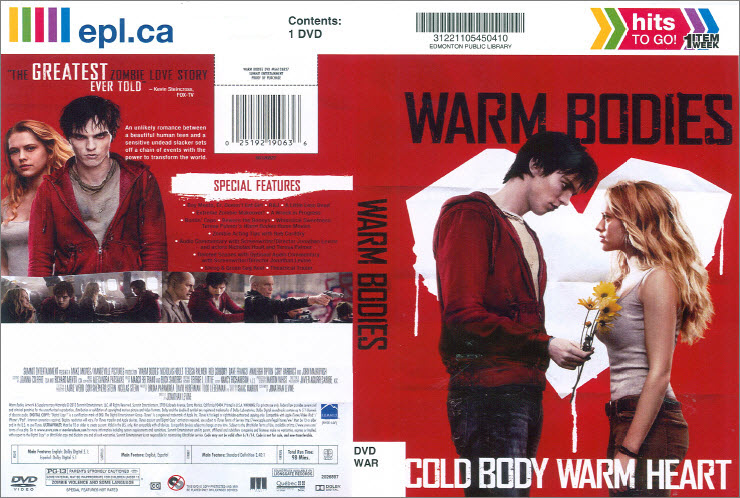
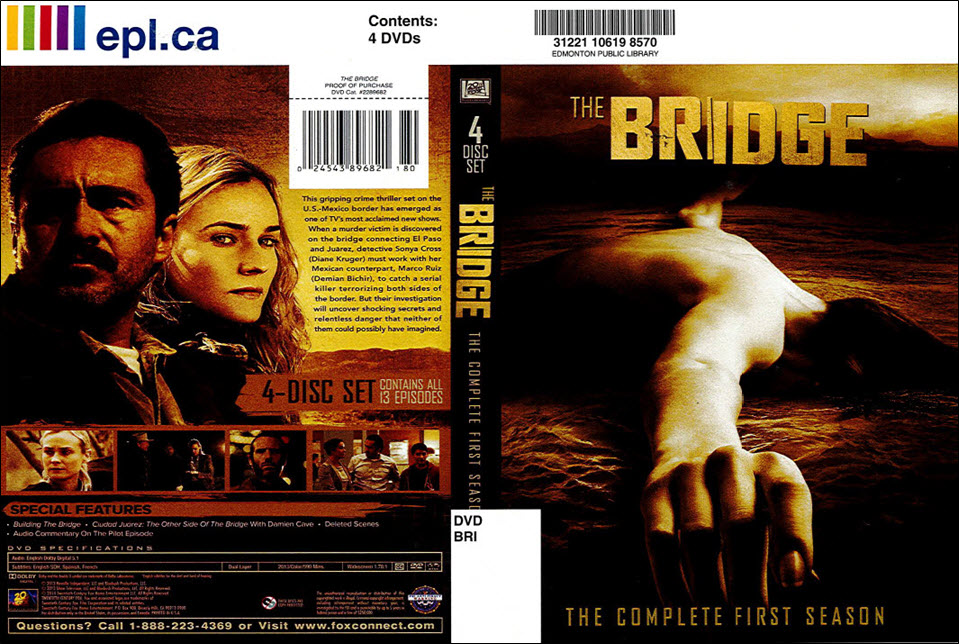
- Affix an RFID tag around the DVD/Blu-ray; for a multi-disc set, affix the RFID tag on the last disc in the set.

- For all DVD/Blu Ray discs, affix the "EDMONTON PUBLIC LIBRARY' hub label with the last 9 digits of the barcode to the centre of each disc, even for discs that do not have a title on the disc and the RFID tag. For any books/booklets present, apply the centre from the donut and affix it to the right hand corner of the booklet and write the last 9 digits of the barcode.
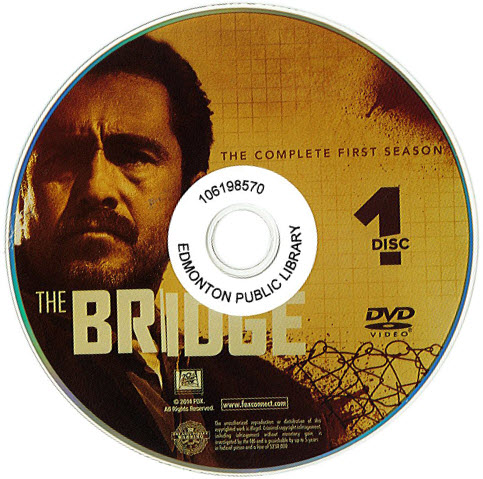
- Apply an 'Oversize' Genre label directly above the spine label if it meets the oversize requirements; see All Formats, Oversize.
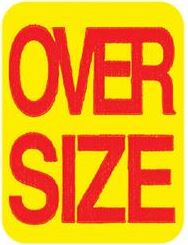
- Repackage a DVD/Blu-ray with accompanying material or a multi-part set of DVD's which is packaged only in cardboard sleeves using a plastic case to accommodate all parts of the set (i.e. discs and booklets).
The Great Courses
- Great Courses items are packaged according to the catalogue record (see above); this may mean a single title is circulated in multiple parts, e.g.
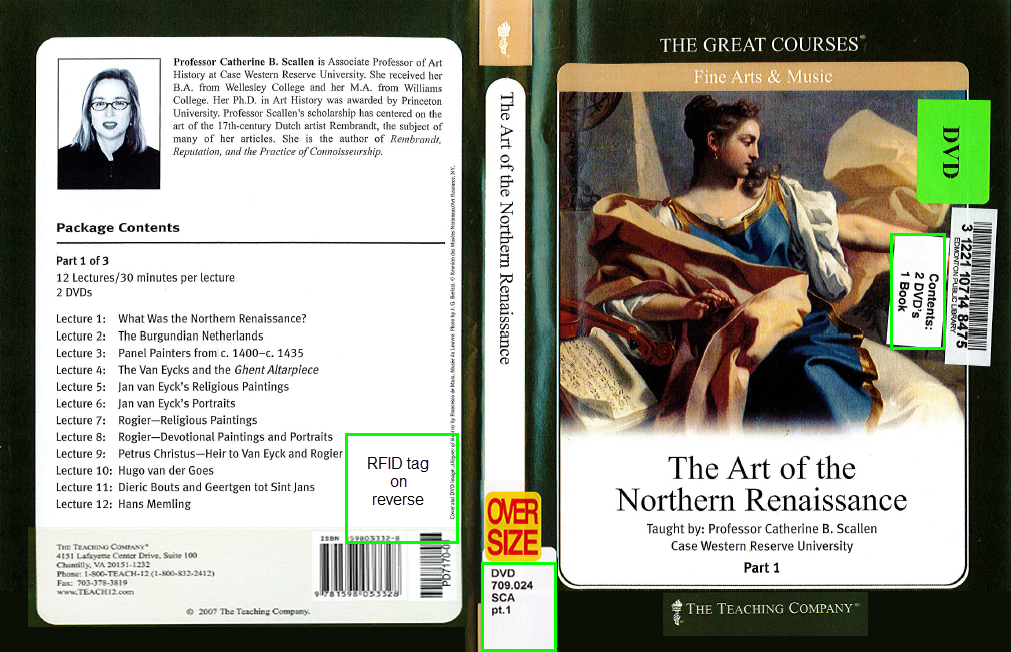
- A contents label listing all components is affixed near the barcode at the same orientation along the right-hand side, along with a DVD label to a cover produced by photocopying the DVD artwork (approx. 130%).
- A D4 RFID tag is affixed to the reverse side of the cover.
- The discs and book(s)/booklet(s) are repackaged in a Unikeep binder (holds 40 or 80 discs), including a regular DVD case or disc sleeves as appropriate, e.g.
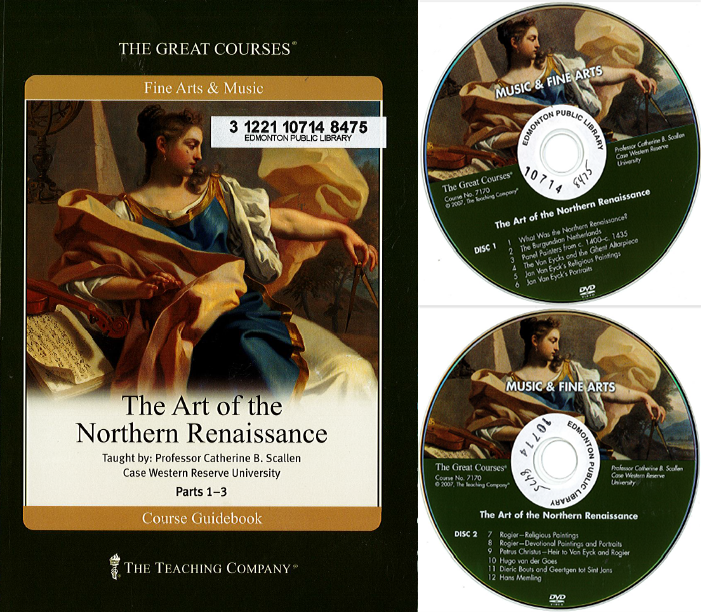
Film Program DVDs
- Occasionally DVDs are ordered by MNA and WMC to be shown publicly.
- The films are not purchased with Public Performance Rights, rather, these service points obtain licenses to show specific movies publicly.
- Use the on-order item for one of the new copies.
- Enter the barcode number over FILM PROGRAM DVD in the Item ID field.
- Assign Item library; Item type; ItemCat1 and ItemCat2 as usual. No PPR.
- Item should have a copy-level request placed by service point staff; the hold should pop when the item is checked out to a Collections card upon completion of processing.
- Other copies in the same order receive normal processing.
Last revised: May 2, 2025